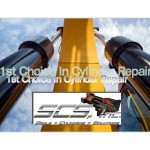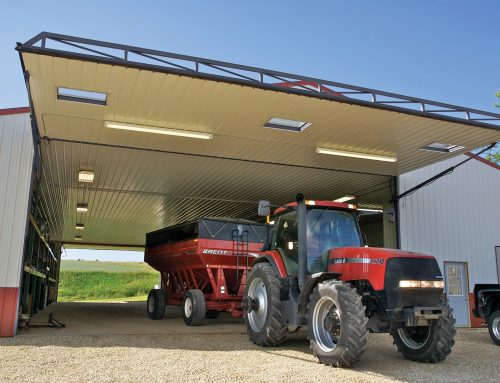Hydraulic Hybrid Cars: No Batteries Required
Even better from an engineering and manufacturing standpoint, what if this hybrid technology didn’t rely on expensive, heavy, bulky battery technologies that aren’t really ready for prime time and instead used a time-tested energy storage method?
Well, there is just such a hybrid-vehicle technology, and it’s one based entirely on hydraulic components rather than electric ones.
In many ways, these hydraulic hybrids conceptually resemble their electric hybrid cousins. Only in this case, energy storage takes place not in a battery but in high-pressure hydraulic accumulators usually charged in excess of 3,000 psi. The best of these accumulators have power densities of roughly 500 kW/kg, according to Jim O’Brien, founder and chief technology officer for Hybra Drive Systems, a start-up focusing on the development of hydraulic power trains.
Design concepts for hydraulic hybrids vary, but typically the car’s diesel or gas engine powers a hydraulic pump motor, which charges that high-pressure accumulator. The accumulator, in turn, drives one or more additional pump motors connected to the wheels. A second lower pressure accumulator typically completes the hydraulic circuit. Depending on the design, there may be one pump motor to drive a pair of wheels through a differential or one pump motor per wheel for an all-wheel-drive version with independent torque control. During braking, the pump motors on the wheels reverse themselves, re-charging the accumulator and capturing energy that would otherwise be lost to heat.
The hydraulic hybrids now under development can communicate with modern engines and do have some electronic controls. Yet in their purest form, they don’t really need any electronics to function. Hybra Drive, for example, has shoehorned a prototype hydraulic power train into a 1968 Volkswagen Beetle. “The only electric thing on that car is the spark plug,” says O’Brien.
Hydraulic hybrid vehicles aren’t exactly news to everyone. Operators of truck fleets have recently taken an interest. FedEx, UPS and Waste Management have been evaluating hydraulic hybrids developed by fluid power players such as Parker Hannifin and Eaton Corp. The U.S. Environmental Protection Agency has also been involved with the design and testing of these vehicles and even showed a hydraulically driven UPS truck at the International Fluid Power Exposition, which devoted two different technical sessions to hydraulic hybrids recently in Las Vegas.
What is new about these vehicles is that a growing chorus of academic researchers, start-up companies and fluid power suppliers are starting to evaluate the suitability of hydraulic hybrid technology for smaller vehicles such as passenger cars and SUVs. None of them claim hydraulic hybrids are going to kill the Prius and its ilk anytime soon. “Electric hybrids have a tremendous amount of momentum right now,” says Simon Baseley, director of engineering strategy and program management for Bosch Rexroth mobile hydraulics. And while hydraulic technology has matured in many applications, it still needs some development work to go into high-volume automotive production. “The major development need right now is for a pump motor with high efficiencies at low displacement,” says James Van de Ven, a Worcester Polytechnic mechanical engineering professor who is researching hydraulic hybrid vehicles. Accumulators also need work to make them lighter, smaller and less expensive to produce. But there has been some recent progress on both scores.
Still, passenger-car-sized applications for hydraulic hybrids may exist right now. Baseley says Bosch Rexroth is involved in a project to evaluate the suitability of hydraulic hybrid taxis and limos for use in New York City. Sponsored by the New York State Energy Research and Development Authority (NYSERDA) and the U.S. Dept. of Energy, the program has enlisted Sure Power LLC to build a hydraulic hybrid limo — known in New York as a “black car” and often based on a Lincoln Town Car. Sal Graven, a NYSERDA spokesman, says the vehicle is nearing completion and will be evaluated on the city streets through 2009.
Other hydraulic hybrid designs are still in the prototype or even simulation stage. The most radical tend to be full-series hybrids, which completely do away with a mechanical transmission. And that makes perfect sense. The biggest potential for fuel economy gains and emissions reductions seem likely to come from power train designs that can break the mechanical link between the engine and wheels — something parallel hybrids like the Toyota Prius do not do. With the engine load decoupled from the road load, the engine can continually be run at or near its maximum efficiency point. Dr. Carsten Breitfeld, BMW’s manager of power train development, said as much in a speech given late last year at the CTI Innovative Transmission Symposium in Berlin. Throw in the potential of full-series hybrids to capture braking losses and allow significant periods of engine-off operation and they become even more attractive from both economy and emissions standpoints.
In theory, any full-series hybrid design could bring about these benefits. “The debate is not really about electric versus hydraulic,” says Peter Achten, director of INNAS BV, a Dutch engineering company that has developed a new class of efficient mobile hydraulic components. “The debate is about getting rid of the traditional mechanical transmission altogether.” And hydraulics turn out to be a promising way to do just that.
Why Hydraulics?
The case for hydraulics boils down to reconciling the contradictory goals of improved environmental performance and cost reduction. “Fuel economy and cost reduction don’t really fit together,” Achten says.
Full-series hydraulic hybrids may help reconcile these goals by drastically improving fuel economy and lowering emissions at costs and weights comparable to a traditional transmission. Consider, for example, a recent simulation of INNAS’s hydraulic hybrid concept as applied to an all-wheel-drive version of the Volkswagen Passat. Conducted by engineers at the University of Aachen in Germany, the simulation mixed computer predictions and measured data from actual hydraulic components.
The simulation results showed the Passat’s hydraulic drive train was about 95 percent efficient, once you add in the vehicle’s regenerative braking energy. That efficiency is only about 4 percent better than a conventional mechanical drive train. Yet, thanks to the hybrid’s engine optimization and engine-off operations, total fuel conversion efficiency jumped from 18 percent with the traditional vehicle to 38 percent with the hydraulic hybrid. “The engine always runs at a high-load, where it’s most efficient,” Achten says. And the engine only had to be on about 9 percent of the time in simulations of the New European Driving Cycle (NEDC). Achten says the overall efficiency gain would improve gas mileage to 6.6 §¤/100 km for the hybrid from 2.9 §¤/100 km for the conventional vehicle and would also result in an emissions reduction of more than 50 percent.
The EPA’s National Vehicle and Fuel Emissions Lab. in Ann Arbor, MI has likewise found fuel economy improvements and other advantages from hydraulic hybrids. The agency’s researchers have, over the years, looked at all kinds of advanced engine and hybrid electric technologies, evaluating them in terms of emissions reduction, fuel economy and cost. “We quickly came to the conclusion that hydraulic hybrids have the best potential,” says John Kargul, technology transfer director at the lab.
Lately, the EPA has been focusing on hydraulic hybrid delivery trucks, but Kargul says the lab has also built and tested smaller vehicles, too,
including one based on a Ford Taurus. Speaking at the recent IFPE Show, Kargul says this 3,800 lb diesel-powered hybrid vehicle chalked up a gas mileage of 85 mpg. Another consumer-sized vehicle, this one based on a Ford Expedition SUV, chalked up an 82 percent improvement in combined city and highway gas mileage. The city cycle was a 130 percent better, Kargul says.
Kargul says the gains came from three sources — running the engine at its sweet spot on the engine map, operating the vehicle with the engine off and capturing braking energy. The regenerative braking capabilities of these systems in particular can far outshine the electric hybrids now available to consumers, something made possible by the high power density of accumulators. Kargul says the EPA’s hydraulic hybrids typically capture at least 70 percent of the braking energy that would otherwise be lost to heat. He estimates electric hybrids capture more like 20 to 25 percent, because their batteries, for all their energy density, have comparatively poor power density. “You would have to triple the size of the batteries to come close to 70 percent,” he says.
These three themes emerge again and again when talking about the performance of hydraulic hybrids. Hydra-Drive, too, has drastically increased mileage of an Humvee for the military and an H1 Hummer that it has retrofitted with a hydraulic hybrid power train as part of a joint development agreement with Gates Corp. O’Brien says the Humvee’s mileage, for example, leapt from around 10 to 23 mpg.
Another interesting aspect of the hydraulic hybrid involves the conditions under which they offer the biggest mileage gains. O’Brien says engine and mechanical transmissions already operate efficiently during highway driving cycles, so the fuel economy improvements offered by hydraulic hybrids are relatively minor on the open road. That’s not the case in cities, though, where start-stop driving and lower power requirements force engines to run at less efficient conditions. Here, hydraulic hybrids offer a bigger fuel economy edge. Achten makes a similar point. “For the first time, hydraulic hybrids allow better fuel consumption in the city than on the highway. And that’s the way it should be,” he says.
In terms of driving performance, hydraulic hybrids have something else going for them — the potential to leverage their high-power-density energy storage capabilities for short-term bursts of power that far outstrip the engine’s nominal power. How much power? O’Brien says Hybra Drive’s Hummer H1 conversion uses a 190 hp diesel engine yet can offer short bursts of power up to 600 hp.
Hydraulics also shine when it comes to delivering fuel economy without paying a cost or weight penalty. INNAS’ simulated vehicle was built around the premise that it be weight and cost neutral with respect to the conventional all-wheel-drive found on the Volkswagen Passat. “There are no compromises. It’s the same cost, same weight,” says Achten. He adds that the transmission for the new vehicle would cost around €15/kg, “in line with the cost for a traditional transmission in Europe.”
Hybra Drive’s real vehicles are “within a couple hundred pounds of being weight neutral,” even as prototypes, according to O’Brien. And hydraulic power trains would add only about 10 percent to the vehicle cost, he estimates. To put that figure in perspective, consider parallel hybrids, like the Prius, add hundreds of pounds and thousands of dollars to the vehicle. He expects costs would fall if hydraulic hybrids moved into high-volume production and the weight penalty would diminish with the development of better accumulators and pump motors. “But we can be successful with the hydraulic components that we have right now,” he says.




